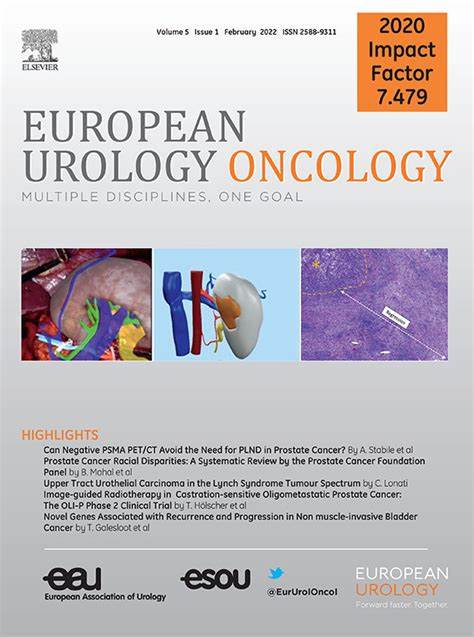根治性前列腺切除术对根据 STAMPEDE 标准选择的高风险非转移性前列腺癌男性生存率的影响:一项 EMPaCT 研究。
IF 8.3
1区 医学
Q1 ONCOLOGY
引用次数: 0
摘要
背景和目的两项随机 STAMPEDE 平台试验的荟萃分析表明,在雄激素剥夺疗法和放疗的基础上,醋酸阿比特龙治疗 3 年可显著改善高风险非转移性前列腺癌(PCa)的无转移和总生存期(OS),应被视为一种新的治疗标准。我们的研究旨在评估符合STAMPEDE高危标准的新诊断非转移性结节阴性PCa患者经手术治疗后的长期癌症特异性生存(CSS)和OS:这是一项回顾性多中心队列研究,研究对象是接受根治性前列腺切除术和扩大盆腔淋巴结清扫术的欧洲泌尿外科协会(EAU)高危 PCa 患者。采用累积发病率曲线评估CSS,采用Kaplan-Meier法评估OS。我们使用Fine和Gray模型评估STAMPEDE高危因素(SHRFs)对CSS的预后价值,并使用Cox比例危险模型评估SHRFs与OS的关系:共有2994名EAU高危PCa患者被分为0、1、2或3个SHRFs组。0-1组与2-3组SHRF患者的10年生存率估计值分别为:CSS为95%对82%,OS为81%对64%(均为P 结论和临床意义:我们的研究结果证实,STAMPEDE 高危标准识别出了具有高度侵袭性 PCa 特征和不良长期肿瘤学预后的患者亚群。这部分患者可能从积极的多模式治疗中获益最多。然而,我们首次证明,对于 STAMPEDE 高危 PCa 患者来说,手术仍然是一种可行的治疗方案。患者总结:符合 STAMPEDE 试验高危定义的前列腺癌是一种侵袭性癌症。我们的长期癌症控制结果表明,对于这类前列腺癌患者,手术是一种可行的选择。本文章由计算机程序翻译,如有差异,请以英文原文为准。
Effect of Radical Prostatectomy on Survival for Men with High-risk Nonmetastatic Prostate Cancer Features Selected According to STAMPEDE Criteria: An EMPaCT Study
Background and objective
A meta-analysis of two randomized STAMPEDE platform trials revealed that 3 yr of abiraterone acetate in addition to androgen deprivation therapy and radiation therapy significantly improved metastasis-free and overall survival (OS) in high-risk nonmetastatic prostate cancer (PCa) and should be considered a new standard of care. The aim of our study was to assess long-term cancer-specific survival (CSS) and OS for surgically treated patients with newly diagnosed nonmetastatic node-negative PCa meeting the STAMPEDE criteria for high risk.
Methods
This was a retrospective, multicenter cohort study of patients with European Association of Urology (EAU) high-risk PCa who underwent radical prostatectomy and extended pelvic lymph node dissection. CSS was assessed using cumulative incidence curves and the Kaplan-Meier method was used to evaluate OS. We used a Fine and Gray model to evaluate the prognostic value of STAMPEDE high-risk factors (SHRFs) for CSS, and a Cox proportional-hazards model to assess the association of SHRFs with OS.
Key findings and limitations
A total of 2994 patients with EAU high-risk PCa were divided into groups with 0, 1, 2, or 3 SHRFs. The 10-yr survival estimates for patients with 0–1 versus 2–3 SHRFs were 95% versus 82% for CSS and 81% versus 64% for OS (both p < 0.0001). In comparison to patients with 0 SHRFs, hazard ratios were 1.2 (p = 0.5), 3.9 (p < 0.0001), and 5.5 (p < 0.0001) for CSS, and 1.1 (p = 0.4), 2.2 (p < 0.0001), and 2.5 (p = 0.0004) for OS for patients with 1, 2, and 3 SHRFs, respectively.
Conclusions and clinical implications
Our results confirm that the STAMPEDE high-risk criteria identify a subgroup of patients with highly aggressive PCa features and adverse long-term oncological outcomes. This population is likely to benefit most from aggressive multimodal treatment. Nevertheless, we have shown for the first time that surgery remains a viable treatment option for patients with STAMPEDE high-risk PCa.
Patient summary
Prostate cancer that meets the high-risk definitions from the STAMPEDE trial is an aggressive type of cancer. Our results for long-term cancer control outcomes indicate that surgery is a viable option for the subgroup of patients with this type of prostate cancer.
求助全文
通过发布文献求助,成功后即可免费获取论文全文。
去求助
来源期刊

European urology oncology
Multiple-
CiteScore
15.50
自引率
2.40%
发文量
128
审稿时长
20 days
期刊介绍:
Journal Name: European Urology Oncology
Affiliation: Official Journal of the European Association of Urology
Focus:
First official publication of the EAU fully devoted to the study of genitourinary malignancies
Aims to deliver high-quality research
Content:
Includes original articles, opinion piece editorials, and invited reviews
Covers clinical, basic, and translational research
Publication Frequency: Six times a year in electronic format
 求助内容:
求助内容: 应助结果提醒方式:
应助结果提醒方式:


